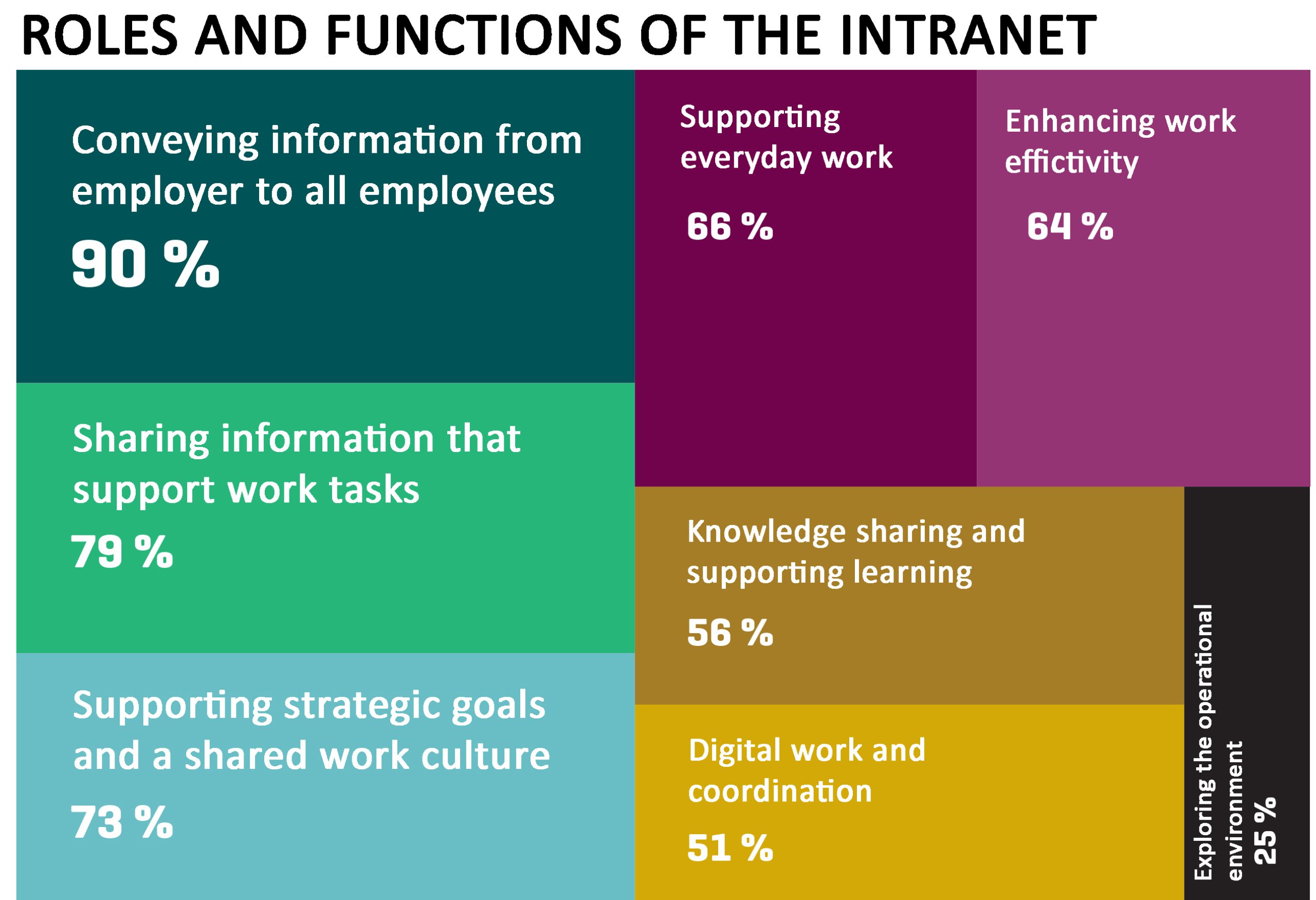What does intranets and digital workspaces look like in Finland in 2018? We conducted a survey, in order to find out roles, functionalities and technologies of the digital workplace as well as to see how organizations develop and lead their intranets and digital workplaces.
North Patrol is a consulting firm specialized in the design of digital services and information systems. We shape ideas into a vision and service concept, find the best architectural and technological solutions, design a functional user experience, and compete to find the ideal partner for implementation work. We do not sell implementation projects, nor do we sell licenses; we are genuinely on the side of the customer.

The concept of an intranet has broadened, and it is more meaningful to speak of digital workplaces. The survey conducted in early summer 2018 focused not only on the traditional intranet, but also on collaboration tools and workspaces and on enterprise social networks. Together, these three dimensions form the digital workplace.
In this article we summarize the typical roles and functionalities of the digital workplace. The most important role of the digital workplace is to share official and common information to all employees and support business, strategic goals and a common work culture.
The traditional intranet
Even though we now talk about digital workplaces, typical intranet content hasn’t disappeared, and organizations still have a need to convey information to all employees. The intranet has just become more confined than before. Social tools are taking over functionalities, that previously where a part of the intranet, and workspaces and other collaboration tools have become an extension to the traditional intranet.
Still, 95 % of the survey respondents say, they have a traditional intranet, which the communication department is typically responsible of. The traditional intranet holds its ground as the number one tool for official internal communication, even though social tools have become increasingly popular. The intranet is first and foremost a channel for organizational news and a depository for HR-instructions and information on internal services. The intranet is in many organizations the starting point for daily work, and it serves as a springboard to other systems and databases.
The traditional intranet is used for following purposes and have following functionalities:
- 96 % HR-information and instructions
- 96 % Internal news
- 94 % Internal services
- 91 % Basic information about the organization, strategy and policies
- 91 % Links to other systems and repositories
- 90 % Internal phone book
- 81 % Descriptions of and instructions on different systems
- 76 % Commenting and/or liking content
- 68 % Everyday information on the operating locations, e.g. parking and conference rooms
- 66 % Events calendar
- 65 % Quality system documents
Enterprise social network
An internal social network enables communication and knowledge sharing throughout the organization. It is a channel for peer support, coordination and collaboration. The social network can be an integrated part of the intranet or the workspaces, but increasingly it is its own tool.
Social tools are primarily used for sharing information that previously was shared via email, word-to-mouth or by tailored functionalities in the intranet. The social network has made internal communication more equal, since the responsibility for sharing information is now shared by the whole organization and not only the communications department or the so-called white collars. The biggest growth with the social tools is seen with the operative personnel.
83 % of the respondents to our survey state that they have an internal social channel either separately or as a part of the intranet or workspaces.
The social channel is most often owned by the communication department.
The Social network is mainly utilized for:
- 90 % Free discussion
- 88 % Sharing ideas and best practices
- 76 % Sharing the atmosphere and feeling of every day work
- 68 % Public thanking and encouraging
- 57 % Peer support
- 54 % Internal news
- 52 % Sharing observations of the operational environment
Workspaces
Workspaces makes it possible to collaborate online and share information in teams, units and projects. There are own tools and places for digital work, and they can either be separate, or as a part of the intranet. 88 % percent of our respondents say they use digital workspaces and that they are most often owned by the IT-department.
Workspaces are typically used for:
- 92 % Project work and different working groups
- 88 % Team/department specific workspaces
- 83 % Working together on documents (even simultaneously)
- 65 % As an Extranet; possibility to invite external members
- 47 % Coordinating work
Digital workplace technologies in Finland
Our survey shows that Microsoft’s tools are very dominant in Finland. Office 365 is growing fast but the most typical intranet platform is still on-premise SharePoint. 46 % of the organizations that participated in the survey have either the whole intranet or a part of it as a SharePoint on-premise installation, of which surprisingly many are still very old SharePoint versions. 27 % of the intranets are O365-intranets. There is a large dispersion of technologies behind Microsoft – from the newest social tools to very old CMS-systems at the end of their lifecycle.
In the workspaces and social networks we see more tools and more modern tools. In workspaces Microsoft is challenged by Atlassian Confluence, Google G Suite and M-Files. As social tools Microsoft’s Yammer and Teams are most popular, but we see also Slack, Google G+ and Workplace by Facebook.
The social network can be a part of the traditional intranet as well, but the trend is to separate it from the intranet. Discussion forums on the intranet is decreasing in popularity.
Mobile use is becoming increasingly important and common, but due to technology choices, social networks and workspaces are more often accessible on mobile devices than the traditional intranet.
Traditional intranet technologies:
- 46 % MS SharePoint on-premise
- 27 % MS Office 365
- 8 % Episerver
- 6 % Atlassian Confluence
- 4 % Liferay
- 29 % Other (e.g. Drupal, Fujitsu NetCommunity, Google G Suite, IBM Connections, P4, WordPress and Workplace by Facebook)
Workspace technologies:
- 55 % MS SharePoint on-premise
- 44 % MS Office 365
- 14 % Atlassian Confluence
- 5 % Google G Suite
- 5% M-files
- 17 % Other
Social network technologies:
- 64 % MS Yammer
- 30 % MS Office 365 Teams
- 22 % Slack
- 7 % Google G+
- 4 % Workplace by Facebook
- 13 % Other
- 11 % Discussion as a part of the workspaces
- 24 % Discussion as a part of the intranet
Note that it was possible to choose multiple options for the workspaces and social network. For instance, many organizations use both Yammer and Teams, but for different purposes. Teams for instance is used for team specific internal discussion whereas Yammer is an open channel for the whole organization.
The survey
The survey was conducted in May/June 2018 and was targeting those responsible for the intranet and/or digital workspace in the organization. The results presented in this article are based on responses from 125 organizations operating in Finland. The survey was previously conducted in 2016 and 2014.


